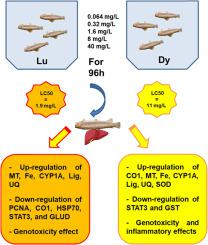Ecotoxicology and Environmental Safety ( IF 6.8 ) Pub Date : 2020-11-09 , DOI: 10.1016/j.ecoenv.2020.111588 Houda Hanana , Zofia E. Taranu , Patrice Turcotte , Christian Gagnon , Joanna Kowalczyk , François Gagné

|
Rare earth elements (REEs) have been recently identified as emergent contaminants because of their numerous and increasing applications in technology. The impact of REEs on downstream ecosystems, notably aquatic organisms, is of particular concern, but has to date been largely overlooked. The purpose of this study was thus to evaluate the toxicity of lanthanide metals, lutetium (Lu) and dysprosium (Dy) in rainbow trout after 96 h of exposure. The lethal concentration (LC50) was determined and the expression of 14 genes involved in different pathways such as oxidative stress, xenobiotic detoxification, mitochondrial respiration, DNA repair, protein folding and turnover, inflammation, calcium binding and ammonia metabolism were quantified in surviving fish. In parallel, lipid peroxidation (LPO), DNA damage (DSB), metallothionein level (MT) and cyclooxygenase activity (COX) were examined. The acute 96 h-LC50 data revealed that Lu was more toxic than Dy (1.9 and 11.0 mg/L, respectively) and was able to affect all investigated pathways by changing the expression of the studied genes, to the exception of superoxide dismutase (SOD), catalase (CAT) and glutathione-S-transferase (GST). It also induced a decrease in DNA repair at concentrations 29 times below the LC50. This suggests that Lu could trigger a general stress to disrupt the cell homeostasis leading to genotoxicity without promoting oxidative stress. However, Dy induced modulation in the expression of genes involved in the protection against oxidative stress, detoxification, mitochondrial respiration, immunomodulation, protein turnover and an increase in the DNA strand breaks at concentrations 170 times lower than LC50. Changes in mRNA level transcripts could represent an early signal to prevent against toxicity of Dy, which exhibited inflammatory and genotoxic effects. This study thus provides useful knowledge enhancing our understanding of survival strategies developed by rainbow trout to cope with the presence of lanthanides in the environment.
中文翻译:

评估暴露于稀土元素s和的虹鳟鱼的一般应激,解毒途径和遗传毒性
由于稀土元素(REEs)在技术中的应用日益广泛,因此最近被确定为新兴污染物。稀土元素对下游生态系统,特别是水生生物的影响尤其令人关注,但迄今为止,人们对其的影响一直被忽视。因此,本研究的目的是评估暴露96小时后虹鳟中镧系金属,(Lu)和(Dy)的毒性。测定致死浓度(LC50),并定量分析了存活鱼类中氧化应激,异物解毒,线粒体呼吸,DNA修复,蛋白质折叠和周转,炎症,钙结合和氨代谢等不同途径的14种基因的表达。同时,脂质过氧化(LPO),DNA损伤(DSB),检查了金属硫蛋白水平(MT)和环氧合酶活性(COX)。急性96 h-LC50个数据显示,Lu比Dy毒性更高(分别为1.9和11.0 mg / L),并且能够通过改变研究基因的表达来影响所有研究途径,除了超氧化物歧化酶(SOD),过氧化氢酶(CAT) )和谷胱甘肽S-转移酶(GST)。在低于LC 50的29倍浓度下,它也会引起DNA修复的减少。这表明Lu可以触发一般应激以破坏细胞稳态而导致遗传毒性而不促进氧化应激。然而,Dy诱导了参与抗氧化应激,解毒,线粒体呼吸,免疫调节,蛋白质更新和DNA链断裂增加的基因表达的调节,其浓度比LC 50低170倍。。mRNA水平转录物的变化可能代表了预防Dy毒性的早期信号,Dy具有炎症和遗传毒性作用。因此,这项研究提供了有用的知识,可增强我们对虹鳟鱼开发的生存策略的理解,以应对环境中镧系元素的存在。


























 京公网安备 11010802027423号
京公网安备 11010802027423号